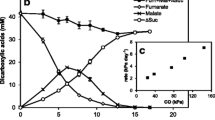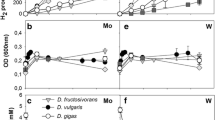Abstract
In a batch culture experiment the microaerophilic Campylobacter-like bacterium “Spirillum” 5175 derived its energy for growth from the reduction of nitrate to nitrite and nitrite to ammonia. Hereby, formate served as electron donor, acetate as carbon source, and l-cysteine as sulfur source. Nitrite was quantitatively accumulated in the medium during the reduction of nitrate; reduction of nitrite began only after nitrate was exhausted from the medium. The molar growth yield per mol formate consumed, Ym, was 2.4g/mol for the reduction of nitrate to nitrite and 2.0 g/mol for the conversion of nitrite to ammonia. The gain of ATP per mol of oxidized formate was 20% higher for the reduction of nitrate to nitrite, compared to the reduction of nitrite to ammonia. With succinate as carbon source and nitrite as electron acceptor, Ym was 3.2g/mol formate, i.e. 60% higher than with acetate as carbon source. No significant amount of nitrous oxide or dinitrogen was produced during growth with nitrate or nitrite both in the presence or absence of acetylene. No growth on nitrous oxide was found. The hexaheme c nitrite reductase of “Spirillum” 5175 was an inducible enzyme. It was present in cells cultivated with nitrate or nitrite as electron acceptor. It was absent in cells grown with fumarate, but appeared in high concentration in “Spirillum” 5175 grown on elemental sulfur. Furthermore, the dissimilatory enzymes nitrate reductase and hexaheme c nitrite reductase were localized in the periplasmic part of the cytoplasmic membrane.
Similar content being viewed by others
Abbreviations
- DNRA:
-
dissimilatory nitrate reduction to ammonia
- 〈N⦔:
-
assimilated nitrogen
- NaPi :
-
sodium phosphate
- OD578 :
-
optical density at 578 nm
- 〈S0〉:
-
elemental sulfur
- “Spirillum” 5175N,F,S :
-
“Spirillum” 5175 grown with nitrate, fumarate or elemental sulfur as electron acceptor
References
Balderston WL, Sherr B, Payne WJ (1976) Blockage by acetylene of nitrous oxide reduction in Pseudomonas perfectomarinus. Appl Environ Microbiol 31: 504–508
Barton LL, LeGall J, Odom JM, Peck HDJr (1983) Energy coupling to nitrite respiration in the sulfate-reducing bacterium Desulfovibrio gigas. J Bacteriol 153: 867–871
Blümle S, Zumft WG (1991) Respiratory nitrate reductase from denitrifying Pseudomonas stutzeri, purification, properties and target of proteolysis. Biochim Biophys Acta 1057: 102–108
Bokranz MJ, Katz J, Schröder I, Roberton AM, Kröger A (1983) Energy metabolism and biosynthesis of Vibrio succinogenes growing with nitrate or nitrite as terminal electron acceptor. Arch Microbiol 135: 36–41
Boltz DF, Taras MJ (1978) Nitrogen. In: Boltz DF, Howell JA (eds) Colorimetric determination of nonmetals. Chemical analysis, vol 8, 2nd edn. John Wiley & Sons, New York Chichester Brisbane, Toronto, pp 197–251
Bronder M, Mell H, Stupperich E, Kröger A (1982) Biosynthetic pathways of Vibrio succinogenes growing with fumarate as terminal electron acceptor and sole carbon source. Arch Microbiol 131: 216–223
Cline JD (1969) Spectrophotometric determination of hydrogen sulfide in natural waters. Limnol Oceanogr 14: 454–458
Cole JA (1988) Assimilatory and dissimilatory reduction of nitrate to ammonia. In: Cole JA, Ferguson SJ (eds) The nitrogen and sulphur cycles. Society for General Microbiology, Cambridge University Press, Cambridge. pp 281–329
Conrad R, Seiler W (1980) Field measurements of the loss of fertilizer nitrogen into the atmosphere as nitrous oxide. Atmos Environ 14: 555–558
Coyne MS, Arunakumari A, Pankratz HS, Tiedje JM (1990) Localization of the cytochrome cd 1 and copper nitrite reductases in denitrifying bacteria. J Bacteriol 172: 2558–2562
Cypionka H, Pfennig N (1986) Growth yields of Desulfotomaculum orientis with hydrogen in chemostat culture. Arch Microbiol 143: 396–399
Denis KS, Dias FM, Rowe JJ (1990) Oxygen regulation of nitrate transport by diversion of electron flow in Escherichia coli. J Biol Chem 265: 18095–18097
Fujita T, Sato R (1966) Studies on soluble cytochromes in Enterobacteriaceae III. Localization of cytochrome c 552 in the surface layer of cells. J Biochem 60: 568–577
Heppel LA (1969) The effect of osmotic shock on release of bacterial proteins and on active transport. J Gen Physiol 54: 95–109
Jackson RH, Cornish-Bowden A, Cole JA (1981) Prosthetic groups of the NADH-dependent nitrite reductase from Escherichia coli K12. Biochem J 193: 861–867
Jones RW, Garland PB (1977) Sites and specificity of the reaction of bipyridylium compounds with anaerobic respiratory enzymes of Escherichia coli. Effects of permeability barriers imposed by the cytoplasmic membrane. Biochem J 164: 199–211
Koike I, Hattori A (1975) Energy yield of denitrification: an estimate from growth yield in continuous cultures of Pseudomonas denitrificans under nitrate-, nitrite- and nitrous oxidelimited conditions. J Gen Microbiol 88: 11–19
Kröger A, Dorrer E, Winkler E (1980) The orientation of the substrate sites of formate dehydrogenase and fumarate reductase in the membrane of Vibrio succinogenes. Biochim Biophys Acta 589: 118–136
Laanbroek HJ, Kingma W, Veldkamp H (1977) Isolation of an aspartate-fermenting, free-living Campylobacter species. FEMS Microbiol Lett 1: 99–102
Lang E, Lang H (1972) Spezifische Farbreaktion zum direkten Nachweis der Ameisensäure. Z Anal Chem 260: 8–10
Liu M-C, Peck HDJr (1981) The isolation of a hexaheme cytochrome from Desulfovibrio desulfuricans and its identification as a new type of nitrite reductase. J Biol Chem 256: 13159–13164
Luria SE (1960) The bacterial protoplasm: composition and organization. In: Gunsalus IC, Stanier RY (eds) The bacteria, vol I. Academic Press, New York, pp 1–34
McEwan AG, Jackson JB, Ferguson SJ (1984) Rationalization of properties of nitrate reductases in Rhodopseudomonas capsulata. Arch Microbiol 137: 344–349
Pope NR, Cole JA (1982) Generation of a membrane potential by one of two independent pathways for nitrite reduction by Escherichia coli. J Gen Microbiol 128: 319–322
Schumacher W, Kroneck PMH (1991) Dissimilatory hexaheme c nitrite reductase of “Spirillum” strain 5175: purification and properties. Arch Microbiol 156: 70–74
Seitz H-J, Cypionka H (1986) Chemolithotrophic growth of Desulfovibrio desulfuricans with hydrogen coupled to ammonification of nitrate or nitrite. Arch Microbiol 146: 63–67
Skirrow G (1965) The dissolved gases-carbon dioxide. In: Riley JP, Skirrow G (eds) Chemical oceanography, vol I. Academic Press, London, p. 227
Smith AF (1974) Malate to oxaloacetate reaction. In: Bergmeyer HU (ed) Methods of enzymatic analysis, vol III. Verlag Chemie, Weinheim Deerfield Beach Basel, pp 166–171
Smith MS (1983) Nitrous oxide production by Escherichia coli is correlated with nitrate reductase activity. Appl Environ Microbiol 45: 1545–1547
Smith PK, Krohn RI, Hermanson GT, Mallia AK, Gartner FH, Provenzano MD, Fujimoto EK, Goeke NM, Olson BJ, Klenk DC (1985) Measurement of protein using bicinchoninic acid. Anal Biochem 150: 76–85
Steenkamp DJ, Peck HD (1981) Proton translocation associated with nitrite respiration in Desulfovibrio desulfuricans. J Biol Chem 256: 5450–5458
Thauer RK, Jungermann K, Decker K (1977) Energy conservation in chemotrophic anaerobic bacteria. Bacteriol Rev 41: 100–180
Tiedje JM (1988) Ecology of denitrification and dissimilatory nitrate reduction to ammonium. In: Zehnder AJB (ed) Biology of anaerobic microorganisms. John Wiley & Sons, New York Chichester Brisbane, pp 179–244
Vries Wde, Niekus HGD, Boellaard M, Stouthamer AH (1980) Growth yields and energy generation by Campylobacter sputorum subspecies bubulus during growth in continuous culture with different hydrogen acceptors. Arch Microbiol 124: 221–227
Vries Wde, Niekus HGD, Berchum Hvan, Stouthamer AH (1982) Electron transport-linked proton translocation at nitrite reduction in Campylobacter sputorum subspecies bubulus. Arch Microbiol 131: 132–139
Wolfe RS, Pfennig N (1977) Reduction of sulfur by spirillum 5175 and syntrophism with Chlorobium. Appl Environ Microbiol 33: 427–433
Yoshinari T (1980) N2O Reduction by Vibrio succinogenes. Appl Environ Microbiol 39: 81–84
Zöphel A, Kennedy MC, Beinert H, Kroneck PMH (1988) Investigations on microbial sulfur respiration. 1. Activation and reduction of elemental sulfur in several strains of eubacteria. Arch Microbiol 150: 72–77
Zöphel A, Kennedy MC, Beinert H, Kroneck PMH (1991) Investigations on microbial sulfur respiration. 2. Isolation, purification, and characterization of cellular components from Spirillum 5175. Eur J Biochem 195: 849–856
Author information
Authors and Affiliations
Rights and permissions
About this article
Cite this article
Schumacher, W., Kroneck, P.M.H. Anaerobic energy metabolism of the sulfur-reducing bacterium “Spirillum” 5175 during dissimilatory nitrate reduction to ammonia. Arch. Microbiol. 157, 464–470 (1992). https://doi.org/10.1007/BF00249106
Received:
Accepted:
Issue Date:
DOI: https://doi.org/10.1007/BF00249106




